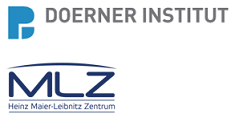Speaker
Description
The blue pigment smalt, a synthetic potash glass tinted with cobalt, was widely used in paintings between the sixteenth and eighteenth centuries [1]. Smalt tends to weather in oil paintings, changing its blue color to a yellowish hue. This alteration is caused by an ionic exchange between $H^{+}$ ions from the environment surrounding the grains and the $K^{+}$ ions from the glass. The leaching of $K^{+}$ ions leads to various phenomena: the leached $K^{+}$ ions can react with the binder, and the leaching causes a charge deficit around $Co^{2+}$ complexes. X-ray Absorption Spectroscopy (XAS) at the Co K-edge reveals that this deficit forces the $Co^{2+}$ complexes to rearrange within the glass matrix, transitioning from a tetrahedral coordination to an octahedral one. This rearrangement explains the loss of color of the pigment in paintings [2][3]. A combination of submicronic X-ray Fluorescence (XRF) and high-resolution µXAS mapping of smalt grains and their surrounding environment at the Co and K K-edges was performed at the ID21 beamline (ESRF), in both historical and mock-up samples within individual paint layers to better understand the degradation process of this pigment and the responsible factors. This allowed us to establish a correlation between the chemical state of the pigment and the color of the grains, as well as to track the chemical transformations of the leached-out $K^{+}$. These measurements revealed distinct spectra for altered and well-preserved smalt grains. Specifically, the more altered a grain was, the more pronounced the white line of the K edge became (Figure 1B). Additionally, analysis of the leached $K^{+}$ ions within the oil medium demonstrated their reaction with other components of the paint, resulting in the formation of salts and potentially soaps (Figure 1C). Findings obtained from SR-µXRF and µXANES at both the Co and K K-edges enable us to establish links between the alteration state of a grain, the coordination of $Co^{2+}$ ions, and the speciation of $K^{+}$ ions. Furthermore, distinct XANES spectra were identified by probing the environment surrounding altered smalt grains at the K K-edge. The characterization of $K^{+}$ ion speciation serves as a means to identify the transformation products resulting from the leaching of K from smalt grains in paints. This approach will enhance our understanding of the smalt alteration mechanism and the factors influencing it.
[1] H. Stege, « Out of the blue ? », Z. Für Kunsttechnol. ZKK, vol. 18, no 1, p. 121‑142, 2004.
[2] M. Spring, C. Higgitt, et D. Saunders, « Investigation of Pigment-Medium Interaction Processes in Oil Paint containing Degraded Smalt », Natl. Gallery Tech. Bull., vol. 26, 2005.
[3] L. Robinet, M. Spring, S. Pagès-Camagna, D. Vantelon, et N. Trcera, « Investigation of the Discoloration of Smalt Pigment in Historic Paintings by Micro-X-ray Absorption Spectroscopy at the Co K-Edge », Anal. Chem., vol. 83, no 13, p. 5145–5152, juill. 2011, doi: 10.1021/ac200184f.

